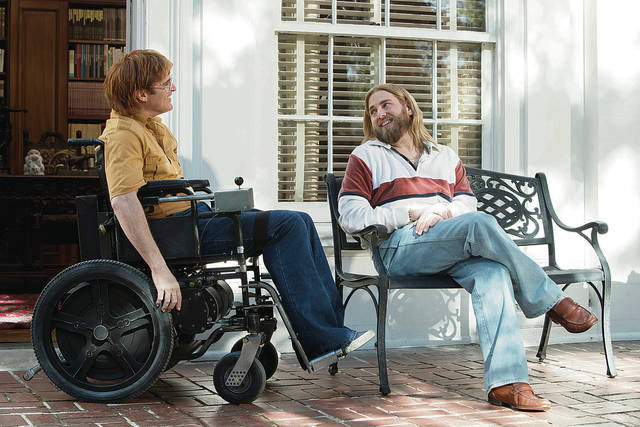The unconventional life of the late cartoonist John Callahan


COURTESY AMAZON STUDIOS
Joaquin Phoenix, left, and Jonah Hill stars in “Don’t Worry, He Won’t Get Far On Foot.”


Macabre is a word often associated with the late cartoonist John Callahan. He’s the man who in his widely published cartoons, drawn in his signature squiggly style, poked fun at lesbians, Chinese people, the handicapped, women, Oprah, Alzheimer’s patients, chiropractors and even sexual harassment in a cartoon that features a woman showing cleavage in a tight dress telling her similarly outfitted colleague, “Remember … it’s only sexual harassment if they’re not dateable.” His website proudly featured all the “hate mail” sent to the newspapers that published his cartoons. It’s extensive.
But John Callahan wasn’t just a provocateur. He was also a quadriplegic alcoholic. In fact, the alcoholism came first, then the handicap, then the cartooning.
Director Gus Van Sant has chosen this very interesting subject for his latest film, “Don’t Worry, He Won’t Get Far on Foot ,” with Joaquin Phoenix starring as the artist. The title is taken from Callahan’s 1990 autobiography, which itself was borrowed from one of his cartoons. That drawing showed a sheriff and his backup on horseback in the desert, commenting on an empty wheelchair that’s been overturned.
Grim, uncomfortably true and funny were Callahan’s main operating modes. It was the only way he could make sense of the world and what happened to him, or so the film posits.
“DON’T WORRY HE WON’T GET FAR ON FOOT”
** 1/2
Don't miss out on what's happening!
Stay in touch with breaking news, as it happens, conveniently in your email inbox. It's FREE!
(R, 1:53)
Van Sant seems to have tried to infuse this work with that same sort of spirit — irreverent, often unattractive, sometimes funny and sometimes offensive. Told in a jumbly, non-linear fashion, Van Sant jumps back and forth in time with disorienting casualness, shifting from a wheelchair bound Callahan as an obviously established and famous artist, back to the last day he walked, and then to the early days of his group therapy. It’s difficult, at the beginning, to wrap your head around just what you’re watching.
Phoenix plays Callahan as a good-time jerk, careless and carefree, affable and sharp-witted with a drink, panicked and cruel without one. The last day he walked, he says in voiceover, he woke up without a hangover. He was still drunk, and just needed to make it to the liquor store before his hands started shaking. That day he met up with another life-of-the-party in Dexter (Jack Black) who tells him that there are better girls at a party across town. Before they get to this grass-is-greener event, however, they stop at more bars, drink more, and, eventually crash. It’s a riveting sequence with devastating consequences for Callahan. Dexter, the driver, leaves the scene with some minor injuries, only to be heard from again in a spellbinding climax.
It’s not exactly a portrait of the artist, as the timeline skips around so frequently that we can hardly grasp Callahan’s evolution, but more so a sort of love letter to 12 Steps, centered around a man who is one of the least likely persons in the world to buy into the philosophy.
But he does, albeit with quite a few struggles and setbacks, thanks in large part to Donnie (Jonah Hill), an addict himself, a sardonic, Jesus-with-an-edge figure who leads a group therapy session made up of his hand-selected “piglets,” as he calls them. Seemingly impervious to therapy, Callahan takes to Donnie, and begins his reinvention, eventually finding art as an outlet.
There are moments of grace and splendor in this film, with an outstanding and wholly surprising performance from Hill. And the film is littered with high profile cameos. Some of them work, like musicians Beth Ditto and Kim Gordon (of Sonic Youth) as two members of Donnie’s group, and some that are distracting, like Carrie Brownstein as put-upon worker in the physical therapy center.
Yet Rooney Mara, one of the most compelling and intriguing actresses working in film today, is a joke in this film. I kept thinking, she can’t possibly only be a pretty, Swedish nurse-turned-stewardess-turned-girlfriend who is just there to make Callahan smile and tell him how special he is, can she? Oh, dear reader, she can and she is, and it is genuinely hard to understand why or how a movie that is so empathetic to so many characters fails one of its main subjects so spectacularly.
There are quite a few good pieces and performances in “Don’t Worry, He Won’t Get Far on Foot,” but, ultimately, it also has the feeling of a first or second draft that isn’t quite where it should be.



